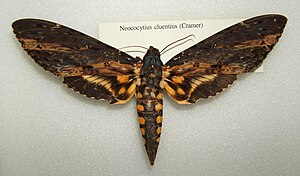Neococytius cluentius
| Neococytius cluentius | ||||||||||||
|---|---|---|---|---|---|---|---|---|---|---|---|---|

Specimen from Neococytius cluentius |
||||||||||||
| Systematics | ||||||||||||
|
||||||||||||
| Scientific name of the genus | ||||||||||||
| Neococytius | ||||||||||||
| Hodges , 1971 | ||||||||||||
| Scientific name of the species | ||||||||||||
| Neococytius cluentius | ||||||||||||
| ( Cramer , 1775) |
Neococytius cluentius is the only butterfly species of the genus Neococytius from the family of hawkers (Sphingidae). The species was originally assigned to the genus Cocytius , based on differences in genital morphology , but separated from this.
features
The moths have a fore wing length of 55 to 92 millimeters and are among the swarmers with the largest wingspan in North America. The long, somewhat narrow forewings are very dark chocolate brown and have some beige stripes. The hind wings are also very dark brown, with a pale yellow medial band and a bright orange band along the wing inner margin to the anal angle and disc region. The proboscis can reach a length of 255 millimeters, even for enthusiasts. The species is similar to Cocytius antaeus , but this species has a transparent area on the hind wings instead of the yellowish medial band. Also in this species the orange band does not reach the anal angle, as in the N. cluentius . The pattern of the N. cluentius is different from its body size and only slightly variable.
The caterpillars are clearly hairy and have nine pairs of well-defined, whitish longitudinal stripes on the sides. The anal horn is very roughly structured and curved backwards. The doll is unique because of its extremely long proboscis, which is wrapped around itself around two and a half times.
Occurrence
The species is neotropically distributed, which is native to much of the north of South America , Central America , Mexico and the Caribbean . The species is rare in Cuba . In the United States, the species flies in the Mississippi Valley and northward to Michigan and Illinois as a rare random visitor .
Way of life
The caterpillars have been detected on the Annonaceae and pepper plants (Piperaceae).
supporting documents
Individual evidence
- ↑ a b c d James P. Tuttle: The Hawkmoths of North America, A Natural History Study of the Sphingidae of the United States and Canada. The Wedge Entomological Research Foundation, Washington, DC 2007, ISBN 978-0-9796633-0-7 .
literature
- James P. Tuttle: The Hawkmoths of North America, A Natural History Study of the Sphingidae of the United States and Canada. The Wedge Entomological Research Foundation, Washington, DC 2007, ISBN 978-0-9796633-0-7 .